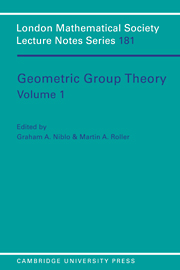Book contents
- Frontmatter
- Contents
- Preface
- List of Participants
- 1 Group Actions and Riemann Surfaces
- 2 The Virtual Cohomological Dimension of Coxeter Groups
- 3 The Geometric Invariants of a Group A Survey with Emphasis on the Homotopical Approach
- 4 String Rewriting — A Survey for Group Theorists
- 5 One Relator Products and High-Powered Relators
- 6 An Inaccessible Group
- 7 Isoperimetric and Isodiametric Functions of Finite Presentations
- 8 On Hibert's Metric for Simplices
- 9 Software for Automatic Groups, Isomorphism Testing and Finitely Presented Groups
- 10 Proving Certain Groups Infinite
- 11 Some Applications of Small Cancellation Theory to One-Relator Groups and One-Relator Products
- 12 A Group Theoretic Proof of the Torus Theorem
- 13 N-Torsion and Applications
- 14 Surface Groups and Quasi-Convexity
- 15 Constructing Group Actions on Trees
- 16 Brick's Quasi Simple Filtrations and 3-Manifolds
- 17 A Note on Accessibility
- 18 Geometric Group Theory 1991 Problem List
11 - Some Applications of Small Cancellation Theory to One-Relator Groups and One-Relator Products
Published online by Cambridge University Press: 15 March 2010
- Frontmatter
- Contents
- Preface
- List of Participants
- 1 Group Actions and Riemann Surfaces
- 2 The Virtual Cohomological Dimension of Coxeter Groups
- 3 The Geometric Invariants of a Group A Survey with Emphasis on the Homotopical Approach
- 4 String Rewriting — A Survey for Group Theorists
- 5 One Relator Products and High-Powered Relators
- 6 An Inaccessible Group
- 7 Isoperimetric and Isodiametric Functions of Finite Presentations
- 8 On Hibert's Metric for Simplices
- 9 Software for Automatic Groups, Isomorphism Testing and Finitely Presented Groups
- 10 Proving Certain Groups Infinite
- 11 Some Applications of Small Cancellation Theory to One-Relator Groups and One-Relator Products
- 12 A Group Theoretic Proof of the Torus Theorem
- 13 N-Torsion and Applications
- 14 Surface Groups and Quasi-Convexity
- 15 Constructing Group Actions on Trees
- 16 Brick's Quasi Simple Filtrations and 3-Manifolds
- 17 A Note on Accessibility
- 18 Geometric Group Theory 1991 Problem List
Summary
Introduction
It was believed for some time that most of the one-relator groups would be small cancellation groups. In this talk I would like to confirm this by showing that, with the exception of a small class of one-relator groups, they are small cancellation groups, and the groups in the exceptional class are small cancellation in a generalized sense, with one exception, where they are only small cancellation groups relative to a subgroup. These results are sufficient in order to regard one-relator groups as if they were small cancellation groups. In particular, we get a solution for the conjugacy problem for all one-relator groups. More precisely, it is shown that Schupp's solution to groups satisfying one of the geometrical small cancellation conditions [5] applies to one-relator groups with one exceptional class, where it is possible to reduce it to a combinatorial problem which cannot be solved by small cancellation theory but can be solved by a very simple combinatorial consideration [4].
The non-small cancellation groups
Let P = (X | R) be a one-relator presentation, R cyclically reduced. If P satisfies the condition C(6) then it is, by definition, small cancellation. So we shall assume that
P does not satisfy the condition C(6).
This means that there is a connected, simply connected, reduced in the sense of Lyndon, Schupp [5] diagram M over R (the symmetrical closure of R) which contains an inner region with less than six neighbours (i.e. a polygon with less than six edges).
- Type
- Chapter
- Information
- Geometric Group Theory , pp. 132 - 137Publisher: Cambridge University PressPrint publication year: 1993



